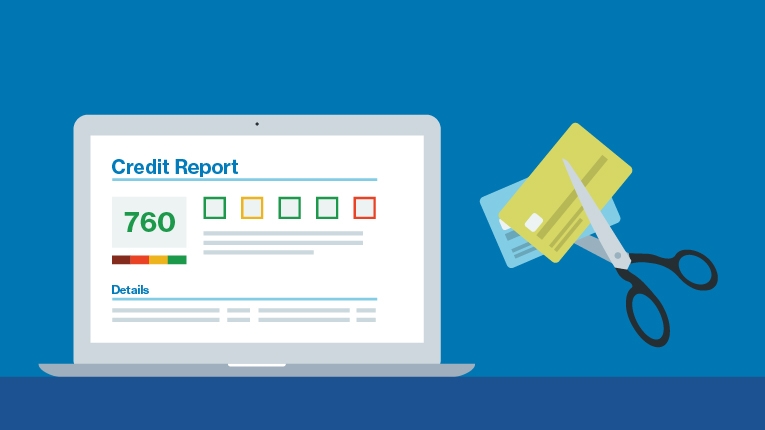How do loans work? Common loan types, how interest works + your pre-loan checklist

Key takeaways
It’s possible to take out a loan from banks, credit unions, online lenders, and other financial institutions.
People with positive credit histories generally qualify for the best interest rates and terms.
Shop around to compare different lenders, interest rates, terms, and types of loans.
Loans can help you cover a big expense, like a home renovation or auto refinancing.[1] Understanding how loans work—before you borrow money—is important. Whether you’re applying for your very first loan or it’s been a while since you last took out a loan, here's what you need to know about how loans work, some of your loan options, and tips to keep in mind before you apply for a loan.
What is a loan and how do they work?
A loan is money you receive from a lender with an agreement to repay the funds later—typically with interest. The loan agreement between you and the lender spells out how and when you will repay the loan, the fees you’ll pay, and how much interest will be added to your debt.[1]
Before you apply for a loan, you’ll need to know what kind of loan you need and how much money you want to borrow. Many factors can affect your loan’s interest rate and repayment term, but your credit history generally plays a big role. So it’s a good idea to check your credit if you’re thinking about getting a loan.[1]
Here’s a quick overview of how the loan process works:
Fill out an application. Borrowers first apply for a loan from a bank, credit union, or other type of lender. You'll need to provide personal information in order for the financial institutions to identify you and understand your creditworthiness when completing an application. You may also need to submit documents to support your financial history, like tax returns.
Receive a lending decision. Once you submit your application, the lender will either deny or approve it based on your creditworthiness and any other factors used in its decision-making process.
Sign loan documents. If the loan is approved, you and the lender will both need to sign a loan contract that outlines the details of your loan agreement, including loan amount, interest rate, payment amount, and terms.
Get funding. Next, the lender will fund, or disburse, the loan amount. For personal loans and other types of unsecured loans, this usually involves depositing the money directly into your bank account. If you’re getting a car loan or a mortgage, the lender usually sends the money directly to the seller. You’d get to drive away in your new vehicle or move into a house instead of receiving money. Funding can be instant or take a few business days, depending on the type of loan and the lender.
Start repayment. Your first loan payment is usually due shortly after you receive your loan funding, although you sometimes have a little breathing room for certain types of loans, like home loans. To avoid missing a payment, take note of your first due date and consider setting up autopay.
Important elements of loans
A loan is made up of several elements, which are all detailed on a loan agreement. These different elements define how much money you’ll receive, the number of monthly payments you’ll make, the amount you’ll pay each month, and more. These components are important to understand when comparing loan offers from different lenders and making sure you can afford to pay back the loan.[2]
Principal
The principal is the initial amount you borrow when you first take out a loan. As you pay down the balance, the principal is the amount you still owe. So if you borrow $15,000 (not including interest), your initial loan principal is $15,000. After you pay down $5,000 of your principal balance, your principal balance would fall to $10,000. When your principal is paid off in full, the loan is considered complete.[2]
Loan term
The loan term, or repayment term, is the amount of time you'll have to repay the entire loan if there are no additional payments or late/skip payments. A shorter loan term can result in higher monthly payments and lower interest costs, while a longer loan term will lower your payments and increase your interest expenses.[2]
Interest rate
The loan’s interest rate is what the lender charges in exchange for lending you money. It’s typically expressed as a percentage of the principal. Interest rates can be fixed or variable. Lenders are often required to advertise an annual percentage rate (APR) in addition to the interest rate. The APR is calculated with the loan’s interest rate and financing fees, so it helps you better understand the total cost of the loan. When comparing loans, you generally want to check the APR as well as the interest rate for a complete picture.[2][3]
Loan payment
The loan payment is the monthly installment you agree to make throughout the loan term. Part of your loan payment goes toward the principal and the rest covers interest. Generally, installment loans, like personal loans, require monthly payments. So if you have a 60-month loan with a $300 monthly payment, you would be on the hook for $300 a month for five years. However, some other loans, such as short-term loans, may require weekly or biweekly payments.[2]
Collateral
Some loans are secured and require collateral, which is something of value that the creditor can take or keep if you don’t repay the loan. For instance, a vehicle is the collateral that secures an auto loan. If you default on the loan, the lender can repossess the vehicle. Unsecured loans don’t require collateral, although creditors can pass the debt to a collections agency, which can negatively affect your credit score. In some cases, lenders can also sue for the money owed.
Origination fees
Origination fees are common for some types of loans, such as personal and student loans. The fee is often a percentage of the loan amount that is withheld from the loan proceeds when the loan is disbursed.[4]
Down payment
Lenders may require you to make a down payment to take out a secured auto or home loan. Even though your property is collateral for the loan, the lender also wants to be sure you have a personal investment in the loan. Down payment requirements can vary, depending on the lender, type of loan, and your creditworthiness. They typically range from 3% to 20% for some home loans and 10% to 20% for auto loans. However, you may also qualify for a loan without a down payment.[2]
Prepayment penalties
A prepayment penalty is a charge you may incur if you pay off a large part (or all) of a loan early. You may encounter prepayment fees on some mortgages and auto loans. The penalty may also only apply during the first several years of the loan. Personal loan lenders may also charge prepayment penalties, although it’s not common.[4]
Other fees
Loans may also come with administrative fees or closing costs, which can add to the total cost of the loan. You may need to pay these fees to the lender or third parties, or you can sometimes add them to the principal balance. Many lenders charge fees based on your actions, such as a late payment fee if you miss a payment.[4]
How are loan interest rates determined?
A loan’s interest rate is the cost of borrowing money. Interest rates are expressed as a percentage of the principal loan amount and are based on a variety of factors, including the overall economy, your credit history, and the lender’s own eligibility criteria. Fixed interest rates won’t fluctuate over the life of the loan—but if your loan has a variable interest rate, your rate may rise or fall when market rates move.[3]
Your creditworthiness is one of the most important factors in determining the interest rate you receive. People with excellent credit typically qualify for the best rates, while people with less-than-perfect or poor credit can expect higher rates. Banks and other types of lenders also have a say in how much interest you’re charged—which is why you’ll likely see a range of advertised rates. Your interest rate is also affected by how much you borrow, the type of loan, and the loan’s terms.[3]
As we mentioned above, loans can come with fixed or variable interest rates. Before choosing a loan, it's important to understand the difference.
Fixed: Loans with a fixed interest rate will charge the same rate for the life of the loan. As a result, your loan payments won’t change, and it can be easier to budget for the future.[1]
Variable: Variable-rate loans often start with a lower interest rate than a comparable fixed-rate loan, but they come with the risk that the interest rate (and your payments) will rise over time.[1]
Loans may also charge interest in different ways, like simple or compound interest, which can also impact the total cost of a loan.
Simple interest is an interest rate that only applies to the loan’s principal balance. Each time you make a payment, part of it goes toward your principal and part goes toward interest. When your principal balance decreases, so does the amount of interest you pay every month. This type of interest is commonly found on personal loans and auto loans.
Compound interest is a type of interest rate that applies to both the principal balance and any interest you’ve accumulated over time. Interest may compound daily, weekly, monthly, or annually. This type of interest is commonly found with revolving credit, like credit cards.
Capitalized interest involves adding unpaid interest to your loan’s principal balance. This can result in more interest accruing—even if you have a fixed-rate loan. This type of interest is common in many student loans.
Precomputed interest is calculated when you take out the loan and spread out between monthly payments. With this type of loan, paying off the loan early won’t reduce the principal or interest you owe, since it’s all determined up front. Some auto loans use precomputed interest.
Common types of loans
Depending on your financial needs, you can choose from a wide range of loans. Here’s a closer look at some of the common types of loans your bank or other lender might offer.
Personal loans
Personal loans are offered by banks, credit unions, online lenders, peer-to-peer lenders, or online lending marketplaces. You can use a personal loan to pay for just about anything—from a kitchen remodel to your dream vacation. Personal loans are typically unsecured, meaning the lender doesn’t require any collateral to issue the loan.[1]
Debt consolidation loans
A debt consolidation loan is a type of personal loan used to pay off high-interest debt, like credit card debt. This type of loan allows you to consolidate multiple debts under one loan (and one monthly payment) and often helps save you money if the new loan has a lower interest rate or better terms.[5]
Auto loans
Also known as vehicle financing or car loans, auto loans are used to buy new or used vehicles. They’re typically available from banks, credit unions, online lenders, or in some cases, directly from a dealer. After financing a vehicle, some people consider using an auto refinancing loan to score a lower interest rate.[6]
Home loans (mortgages)
A mortgage is a type of secured loan used to purchase a home. Lenders use the home as collateral to secure the loan. Mortgages are available through banks, credit unions, online lenders, and mortgage brokers.[7]
Student loans
Student loans help pay for higher-education expenses like tuition, books, and housing. The government offers federal student loans, which typically don’t have a credit score or income requirement. Private student loans from banks and lenders are also available, but they generally don’t offer as many protections or benefits as federal student loans.[8]
Small business loans
Small business loans are used by companies to help pay for startup costs, new equipment, operations, and business expenses. Traditional small business loans are available from banks and credit unions, but not all businesses may qualify. Some business owners also choose a government business loan, nonbank business loan, or micro loan.[9]
Tips for getting a loan
Applying for a loan may feel a bit overwhelming—especially if it's your first time trying to take out a loan or you’re not sure about your eligibility. Here are some tips to keep in mind.
Know your needs and limits. Before applying, it’s important to determine how you intend to use the loan, how much you need to borrow, and how much you can afford to pay each month.
Review your income and debt payments. Your debt-to-income (DTI) ratio shows lenders how much of your monthly income goes toward debt payments. If you pay $1,000 a month and earn $5,000, for example, then your DTI ratio is 20%. Generally, a low DTI ratio—usually under 36%—could make it easier to qualify for a loan and manage your bills.[10]
Check your credit. Your credit history and credit scores can be important factors in determining whether you qualify for a loan and how much you’ll pay in interest. Good credit is typically defined as a score in the high 600s, but a score in the mid to high 700s can help you qualify for the best rates. Check your credit reports to know your score and look for inaccuracies. If your credit isn’t so hot, take action to improve your creditworthiness. And if you find abnormalities in your report, dispute them with one of the three credit bureaus immediately.[11]
Get your paperwork together. Lenders may require copies of personal documents to verify your identity and income. These may include a government-issued ID, lease, utility bill, pay stubs, tax returns, Social Security number, and insurance documents.
Compare rates and terms. Shop around with multiple leaders to find the best interest rates and loan terms. Some lenders, like LendingClub, allow you to check your loan rate without impacting your credit score.
Consider fees. Most lenders charge an origination fee, but some lenders may charge hefty penalties for making late payments or paying off the loan early.
Watch out for scams and predatory lenders. Know the signs of common loan scams, like advance-fee loans, and avoid high-interest loans that prey on people with poor credit, like payday loans and auto title loans, whenever possible.[12]
Research the lender. Check out customer reviews and ratings online to see what others have to say about the lender. Online resources like the Better Business Bureau, the Consumer Financial Protection Bureau, TrustPilot, and Google all allow you to search past complaints and ratings.
Get a co-borrower or co-signer. Having a family member or friend with a good credit history may help you qualify for a loan. A co-signer guarantees the loan in the event you can’t pay it back, while a co-borrower is equally entitled to the loan proceeds and responsible for payments.[13]
The bottom line
Getting a loan can feel like an overwhelming process—especially if it's your first time getting a loan or it’s been a while since you last borrowed money. Before you apply, it’s important to do your research, understand how the type of loan you need works, and what you’ll be responsible to pay back. Once you have a loan, be sure to make your payments on time to avoid negative reports to the credit bureaus or defaulting on the loan.
Consumer Financial Protection Bureau. “What is a personal installment loan?”
Consumer Financial Protection Bureau. “Loan Estimate Explainer”
Consumer Financial Protection Bureau. “What is the difference between a loan interest rate and the APR?”
Consumer Financial Protection Bureau. “Do personal installment loans have fees?”
Consumer Financial Protection Bureau. “What do I need to know about consolidating my credit card debt?”
Consumer Financial Protection Bureau. “What are the different ways to buy or finance a car or vehicle?”
Consumer Financial Protection Bureau. “Mortgages.”
Consumer Financial Protection Bureau. “Student loans.”
FDIC. “Need a Loan for Your New Small Business?”
Fannie Mae. “B3-6-02, Debt-to-Income Ratios.”
Consumer Financial Protection Bureau. “How do I get and keep a good credit score?”
Federal Trade Commission Consumer Advice. “What To Know About Advance-Fee Loans.”
Federal Trade Commission Consumer Advice. “Cosigning a Loan FAQs.”




